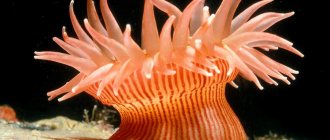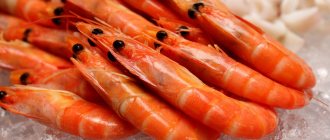The Australian crayfish is a pet that is loved by many aquarists and does not require complex care. This beautiful creature feels comfortable in muddy water and is insensitive to small temperature changes. Possessing a purposeful character, the crayfish rearranges the bottom decorations in a masterly manner, decorating the home to its taste.
General description of Australian cancer
Crayfish lives in freshwater bodies of New Guinea and Australia, preferring wastewater: rivers, ponds. Its favorite habitat is small streams with virtually no current. This feature allows you to keep your pet at home.
Appearance and photo
The arthropod is protected by chitinous armor. The main color is blue, but there are individuals of brown and green colors with a hint of purple. There are yellow spots on the surface of the shell.
The color is determined by the habitat. If the water is hard, the color will be bright; soft water will provide a pale shade.
In nature, crayfish grow up to 30 cm and weigh 0.5 kg. When kept at home - up to 25 cm and 0.4 kg.
Character and behavioral characteristics
The body size of the crayfish is rather large, and the creature is the most peaceful of all arthropods.
The water in which it is contained affects not only color, but also behavior. In hard water, aggressiveness towards others may appear. Nevertheless, the pet is able to get along with small and large fish.
Adults can eat young animals, so it is better to keep crayfish of the same size and age in the same aquarium. A large number of males is undesirable: during molting, energetic arthropods can eat their fellows.
With the onset of night, the crustacean becomes active and restores order in the aquarium - dragging decorations and moving shelters.
During the day, the pet hides and comes out only to satisfy its hunger and during molting.
Varieties of Australian crayfish
Types of crustaceans:
- Australian crayfish Yabbie . A blue arthropod with large claws grows up to 20 cm, is aggressive, and loves to destroy everything. Life expectancy in captivity is from 2 to 4 years. Lives in muddy water with a lot of vegetation.
- Red claw crayfish . It has a bluish-green body color, a large tail, red stripes and spiked growths on its claws. Reaches sizes from 14 to 20 cm. In natural conditions, it lives at the bottom of lakes and rivers.
Sexual characteristics
Sexually mature males are distinguished by the presence of a wide, flat, red growth on the lower part of the claw. Females are characterized by a small body size and neat claws without spines.
Taste and aromatic differences between males and females
The taste and aroma of male and female individuals is practically no different. However, you have probably noted more than once that large arthropods, unlike small ones, have a more pronounced and rich taste of meat. At the same time, the meat of females is a little more tender due to less movement, unlike males . The aromatic component of female arthropods is less vibrant than that of similar males.
Pros and cons of home keeping
The main advantage of keeping crayfish is the ease of care that even a beginner can handle.
Without experience in handling arthropods, it is enough to study the recommendations of specialists and strictly adhere to all requirements.
The crustacean has an attractive appearance, so it will decorate any aquarium and capture the attention of others.
You can watch his creative ideas and peaceful movements for hours.
The crustacean does not have many disadvantages:
- plucks plants;
- constantly digs up the soil;
- sometimes hurts small fish.
Enterprising owners can build a business on red claw crayfish by mastering the intricacies of their reproduction process.
Breeding Features
Knowing how much cancer grows and how to care for it, you can think about a home business. To do this, all the features of animal breeding are taken into account.
- Temperature. For adult crayfish, the water temperature should be about 20 degrees. To accelerate the development of larvae, maintain a temperature of 23 degrees. In cooler water, crayfish eat less and grow less well.
- Aeration. In ponds, water is saturated with oxygen naturally. In aquariums, aeration is carried out forcibly.
- Diseases. Cancers can be susceptible to infectious and invasive pathologies.
To speed up weight gain, the right food for crayfish is selected. It should be nutritious, high in calories and contain a high amount of protein.
Conditions for keeping crayfish
The first thing to do is to provide a good aquarium at the rate of 100-150 liters of water per adult. Decorations and multi-colored elements are placed at the bottom, with the help of which the territory will be divided.
Growing crayfish native to Australia requires maintaining temperature conditions in the range from +20 to +26°C.
In water that is too cold or warm, the crustacean may die. A pet can be too warm, but its life expectancy is shortened.
Who can Australian crayfish live next to?
The crustacean gets along well with many inhabitants of the aquarium, but not with its relatives. Together with it, it is best to place small fish that will clean the crayfish’s shelter from debris, for example:
guppy
corridors
Small fish do not leave behind a large amount of waste, so the risks of damaging water and plants or developing arthropod diseases are minimal.
It often happens that small fish die due to overeating. In this case, their remains will not cause contamination of the tank, because the orderly crab eats them.
Aquarium characteristics
The crustacean will need an aquarium with a wide bottom so that it has room to roam around and shed its shell during molting. For 2-3 individuals, a volume of water of 200 liters is required. The height of the tank should be sufficient so that the pet does not escape.
Placed on the bottom will help brighten up the arthropod’s leisure time:
colorful pebbles and shells
artificial flowers
ceramic pipes and pots
driftwood
soil (quite thick layer)
It is better to avoid large stones, because they are of no interest to the pet, and the cancer will appreciate the presence of pots and pipes and will immediately organize a shelter there. It is important to provide a place for walking on land, protecting the arthropod from other curious pets.
Soil and vegetation
Suitable soil:
- sea or river pebbles;
- purchased artificial soil;
- red crushed brick;
- fine expanded clay, previously soaked in water.
The thickness of the soil is up to 6 cm, the pebbles included in it should be 0.3-1.5 cm in diameter. This is necessary so that the crayfish can comfortably dig holes and build shelters.
Plants are a must, as greens are included in the cancer’s diet. He willingly eats grass that he can reach. Floating vegetation is suitable for decorating an aquarium:
elody
Riccia
duckweed
The slow-moving crustacean will not be able to eat all the duckweed because it grows quickly. You can please your pet with string, which he loves to rummage through. But before purchasing, you should clarify its origin. If the filament is removed from an open reservoir, it can cause the development of bacteria that are dangerous to the inhabitants of the aquarium.
Water composition
The hydrochemical composition of water is not too important. But, according to the general conditions, for keeping aquarium crustaceans it is necessary to adhere to the following parameters:
- hardness - no more than 20°dH;
- acidity - from 6.5 to 7.8 pH.
During the molting period, attention should be paid to rigidity. Too soft water has an adverse effect on the renewal of the chitinous shell.
Mating crawfish games
Before mating, females usually moult. At the same time, special substances - pheromones - are released into the water to attract males. Having received such a signal, the gentleman immediately goes in search of his lady and begins to wander around the aquarium. Before mating occurs, the male “courts” his partner, touching her with special antennae.
The mating process of crayfish.
Then suddenly the cancer will begin to follow its natural instincts and “catch” the female, but not with its claws, but with its abdominal legs, which are also quite strong and dexterous. From a romantic tramp, cancer turns into a real hunter, ruthless and persistent. He wraps his legs around his girlfriend and presses against her with the tubular holes on her body. Crayfish usually mate in a fierce struggle: the male holds the female, who resists with all her might, trying to escape. And here everything depends on the size of the future parents. If a male crayfish is inferior to his partner in strength and growth, fertilization may not occur. But if the gentleman is too strong and strong, he can easily kill the girl during the process, and with her the future offspring - the fertilized eggs.
After successful mating, the crayfish girls with fertilized eggs return to their shelter and try not to leave there during the daytime, while the anxious males continue to look for love affairs . Under the power of natural reproductive instincts, a male crayfish can successfully fertilize 2-3 partners, after which he languishes from exhaustion and hunger. It costs him nothing to turn on his ancient instinct and dispassionately devour his last fertilized girlfriend after intercourse.
After fertilization, the male's role in the development of the offspring ends. All worries fall on the fragile “lady’s shoulders,” or rather, on her tail.
Feeding and basic diet
The Australian crayfish is called a vegetarian, which is not true.
He eats both plant and animal foods.
Its menu may include snails, frogs, small fish and even relatives.
The diet should be varied, and it is important to take into account your favorite dish - beech or oak leaves.
In nature, crayfish consume them every day, getting full and at the same time preventing diseases. The absence of such foliage in the diet leads to disease.
Suitable Products:
- store-bought fish food;
- worms, bloodworms, frozen larvae;
- pureed, boiled vegetables;
- stale bread soaked in water;
- boiled egg white and shell.
Products to avoid:
- raw vegetables;
- apples;
- raw meat products;
- fresh bread;
- banana peel;
- minced fish or meat;
- boiled yolk.
These products not only harm your pet, but also seriously spoil the water.
Conditions in the breeding aquarium
Breeding aquarium crayfish does not require special experience or much effort from the owner. It is enough to take care of equipping the crayfish’s home, and then nature will do everything itself.
Crayfish are bottom-dwelling creatures, so the wider the aquarium, the better. Height is not so important for these animals, but the total volume of their home should be at least 150 liters. A prerequisite is a regular supply of oxygen and high-quality cleaning of the aquarium.
For successful breeding of crayfish, it is necessary to create shelters for them, for which a variety of tubes are perfect.
For successful breeding of crayfish, it is necessary to create shelters for them, for which a variety of tubes are perfect.
It is recommended to cover the bottom with river sand, small colored pebbles, driftwood, pipes and pots - in short, everything in which the crayfish will swarm and where they can hide. The optimal water temperature in the aquarium for reproduction is 18-20 ° C. A lower temperature will cause the crayfish to slow down its development and go into hibernation. And some species of aquatic organisms may even die from hypothermia.
If your plans include breeding aquarium crayfish, you need to stock up on a few more containers in advance. Alas, crayfish sometimes turn into cannibals and eat their offspring.
Controlling the molting process
During the first year of an arthropod's life, up to 8 molts occur, in the second year - about 5, and then - several times a year.
Shedding their shell weakens the pets, their body becomes soft and easily injured, so care should be taken to have individual shelters: large shells, plastic or ceramic pipes.
Here the crayfish will hide until they grow a new shell. This takes on average a week. An observant owner can determine the approach of molting in 2-3 days. At this time, the crustacean refuses to eat and makes scratching movements with its back.
You can tell that molting has already begun or passed by the presence of a removed shell. It separates within 1-2 minutes. Crayfish molt mainly at night, so the process of removing the shell is difficult to see.
In order for a new protective shell to form quickly, a large amount of calcium is required in the diet. Sometimes crayfish eat their shell to replenish calcium reserves, so the crustacean’s “old clothes” should not be removed from the aquarium.
To replenish calcium deficiency, you should include calcined cottage cheese in the menu, and add calcium tablets to the water.
Features of molting in crayfish
Many arthropods undergo regular molting. Cancer is no exception, so you need to understand how to determine shedding.
Large crayfish have a coat that is highly rigid and based on chitin. For this reason, crayfish must regularly shed their shell, covering themselves with a new one. If you notice that the aquarium inhabitant is hiding more and longer, he decides to molt.
Either sex can successfully shed its shell, which will subsequently lie on the bottom of the aquarium. However, the shell does not need to be removed, since after molting it will be eaten. The composition contains a large amount of calcium, which is required to renew the skin. Regardless of which sex the crayfish is, it takes three to four days for a successful molt to complete if the previous shell is eaten. Juveniles molt more often, but the frequency subsequently decreases.
Reproduction of Australian crayfish at home
Many aquarists try to breed crustaceans, but encounter some difficulties. Often the arthropods living in the tank are of the same sex, so before starting breeding you should make sure that there are females and males.
To breed crayfish, you will need an aquarium with a bottom area of 0.4 square meters. m for one family.
To stimulate sexual desire, the female and male are placed in different containers for 7 days. A week later, a “date” is arranged, which will result in the appearance of eggs under the female’s tail.
Maximum number of fry
Pregnancy ends with the appearance of 500 to 1500 eggs. The average duration of embryo maturation is about 9 days. After the fry appear, the female is removed.
More crustaceans die. Their growth and development occurs unevenly, with the strongest surviving. As they grow, crustaceans eat their own kind.
To preserve a large brood, you need to immediately put them in different tanks, sorting them by size. In this case, the losses will not be too great. In order to preserve weaker offspring, they are covered with fallen leaves, which will serve as protection and nutrition.
Why do people breed crayfish?
In recent years, people have become increasingly creative with business ideas. Whatever one may say, crayfish breeders often pursue financial gain. Crayfish meat is always in demand, and there are very few competitors in this business. But no large farm will dare to throw in its lot with crayfish farming. This is ineffective - large volumes of this expensive product will be difficult to sell. And, accordingly, it will not be possible to quickly return your initial investment (and it will be considerable).
But breeding generations of crustaceans in home aquariums will not be difficult. In addition, things will go much faster, because a person can interfere with natural processes and speed them up. If you create favorable conditions for crayfish and set the optimal water temperature for life, their development and reproduction will be stable all year round. This exotic product will definitely find its regular buyer.
Dwarf crayfish with caviar.
But breeding crayfish in an aquarium is not always a business. Some owners are driven by ordinary human curiosity or the desire to get offspring from their beloved pet. Dreams come true if you put a little effort into them. The first thing the owner needs to do is learn to determine the gender of these amazing creatures . Very often, inexperienced owners place two same-sex hydrobionts in an aquarium and expect miracles from them. Some generally think that crayfish are hermaphrodites, and therefore it is useless to look at them. Cancers, indeed, can look exactly the same (sometimes their sexual characteristics seem to be “erased”), but these creatures are strictly divided into boys and girls.
Vegetation
Australian crayfish love vegetation, so they eat everything they can get. But it is possible to keep plants such as duckweed and pistia, which floats on top. For a continuous supply of greens, it is better to have an aquarium donor. Of all the plants, Cliffiflora is the longest. Duckweed also spreads quickly, so this is a way out of the situation. Young crustaceans love to hide in plants and at the same time gradually eat them..Water temperature The Australian crayfish tolerates temperature fluctuations persistently; temperatures below 17 C are fatal; if the temperature drops for a long time, the pet can die from hypothermia. The optimal temperature for ACCR is 27-28C. It can tolerate temperatures of 30 C for a short time, but in this case there must be an additional supply of oxygen in the water. Feeding crayfish Young crayfish are not too demanding when it comes to food, but they are fickle in choosing a menu. Despite the fact that they are vegetarians by nature, these creatures are not averse to trying frogs, small fish, snails, maggots, and bloodworms. But the diet for your pet should be made taking into account its feeding in natural conditions. They usually have oak or beech wood in abundance. This "dish" for Australian crayfish is considered a delicious delicacy. In addition, the foliage is a true antiseptic, without which the health and immunity of cancer will decrease. If your diet lacks oak leaves, your cancer will be susceptible to diseases. But besides this, you can dilute his diet with frozen foods, earthworms, various vegetables, snails, fish food (with mineral supplements and calcium).
Central lung cancer
This cancer is located in the large bronchus. It has early symptoms due to the fact that the bronchial mucosa is irritated, the ventilation and patency of this part of the lung is impaired. Due to the fact that the nerve trunks are irritated, pain and pleurisy occur. Metastasis causes pain in other organs. When the tumor grows into the bronchus, a cough with hemoptysis and sputum appears.
Cancerous pneumonia then develops, causing shortness of breath and purulent discharge. Pneumonia of this nature is suppressed by anti-inflammatory drugs, but then reappears. Sometimes with such pneumonia, hemorrhagic pleurisy may occur.
Due to further growth of the tumor, the vocal muscles are paralyzed and the voice becomes hoarse. Paralysis of the diaphragm may occur due to tumor penetration into the phrenic nerve.
When the tumor grows into the pericardium, pericarditis can form. If the lesion occurs in the superior vena cava, then the lymphatic and venous outflow of blood from the upper part of the body is disrupted. Because of this, the face swells, hyperemia occurs, veins swell in the arms, chest, neck, headaches and shortness of breath occur, and vision problems appear.
What to feed aquarium crayfish?
Feeding orange crayfish is not difficult. They feed on any organic matter, for example, plant remains; crayfish will happily accept any fish food into their diet. Food tablets for catfish-like fish and sinking granules are especially good. They enjoy eating live food: bloodworms, brine shrimp, daphnia, etc. They eat scalded pieces of cucumber or zucchini, carrots perfectly. It is worth noting that crayfish are considered “aquarium orderlies” - they will always eat carrion.
Pet character
Despite its rather small size, ACCR (this is its abbreviated name) is considered one of the most peaceful crayfish. The content of such cancer showed that its color is affected by water hardness. But this water indicator also affects the aggressiveness of cancer. Harder water can make it more hostile to its fellow creatures. Despite this, the Australian crayfish is capable of peaceful coexistence with fish, and with those fish that are larger than it can live in the same shelter. A larger ACCR can eat young crustaceans, so it is advisable to keep individuals of the same age and size. In addition, if there are too many males in the aquarium, then during molting the energetic crayfish will eat their “rivals”. This type of cancer is nocturnal and prefers to hide in a shelter during the day. During daylight hours, they can come out of the shelter to have a snack or to molt (they need free space for this). But if the cancer has not crawled out for these purposes, this may be a signal that something is wrong in your aquarium. Australian crayfish are creative creatures that can move hiding places and different aquarium decorations at will.











